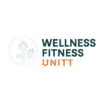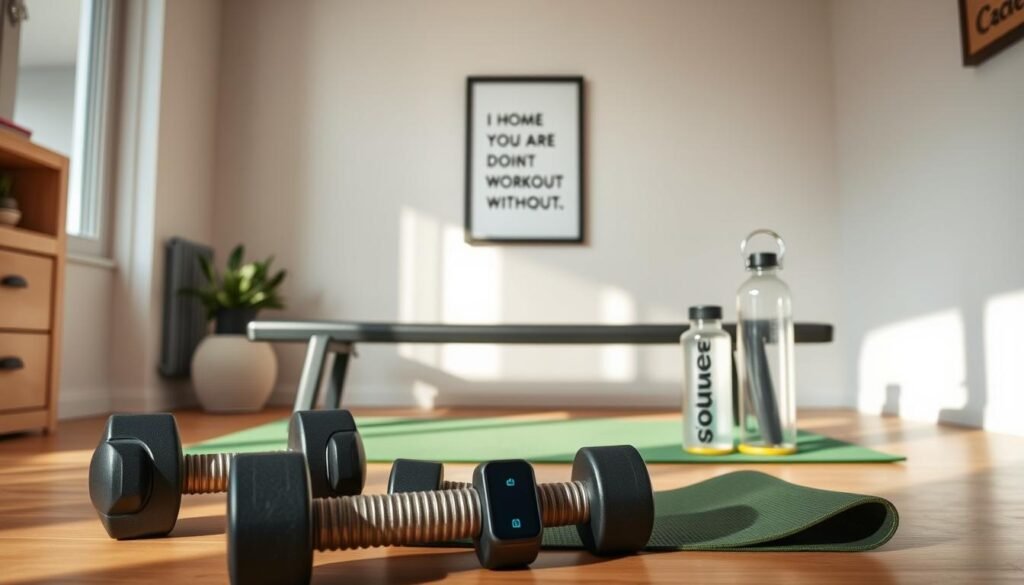Exercise does more than just shape your body. It boosts your mood, helps manage weight, and lowers risks for heart disease and diabetes. Whether you want to feel happier today or build healthier habits for life, moving your body delivers results. The best part? You don’t need a gym membership or fancy gear to see progress.
Creating a fitness routine in your living space offers unmatched flexibility. Skip the commute, avoid crowded locker rooms, and exercise whenever your schedule allows. With smart planning, even small areas can become effective workout zones. All it takes is a little creativity and the right approach to stay consistent.
This guide walks you through everything for getting started with working out at home. You’ll learn how to design a functional space, choose affordable equipment, and build routines that match your goals. We’ll also share motivation hacks to keep you energized, even when life gets busy.
Key Takeaways
- Daily movement improves mental health and lowers long-term health risks
- Home workouts save time and money compared to gym memberships
- Effective exercise spaces require minimal equipment and planning
- Consistency matters more than workout length or intensity
- Personalized routines increase adherence and results
Assessing Your Current Fitness Level

Before starting a home workout, it’s important to know your current fitness level. This is like having a roadmap for your fitness journey. It helps you avoid injuries and sets realistic goals. Let’s look at how to evaluate your starting point.
Understanding Your Fitness Goals
SMART goals – Specific, Measurable, Achievable, Relevant, Time-bound – are the best. For example, aiming to do 20 push-ups in a month is a clear goal. A 2023 study by the American Council on Exercise found people with clear goals stick to workouts 40% longer.
Ask yourself:
- Are you aiming for weight loss, muscle gain, or better flexibility?
- How much time can you realistically commit weekly?
- What activities do you enjoy? (Hint: You’ll keep doing what you like)
Identifying Strengths and Weaknesses
Try these baseline tests to spot areas needing attention:
- Track daily steps for three days using your phone
- Time how long you can hold a plank
- Measure how far you can reach forward in a seated stretch
Notice knee pain when squatting? Can’t catch your breath after climbing stairs? These clues help tailor your routine. As physical therapist Dr. Lisa Monroe advises, “Work with your body, not against it.”
Starting a home workout routine isn’t about being perfect. It’s about building from where you are today. Track these initial metrics – they’ll make your progress visible down the road.
Creating a Dedicated Workout Space
Turning a part of your home into a workout area is easy with smart planning. Having a special spot helps you stay focused and avoid distractions. It makes fitness at home feel more purposeful. Let’s explore how to make the most of even small spaces.
Choosing the Right Location
First, look at the areas you have available. Choose spots that:
- Have enough room for moving around
- Get plenty of light, natural or artificial
- Have good air flow
For instance, a hallway can be a yoga spot with foldable mats. A garage corner is great for strength training with rubber flooring. Make sure to measure the area to fit your equipment like resistance bands or dumbbells.
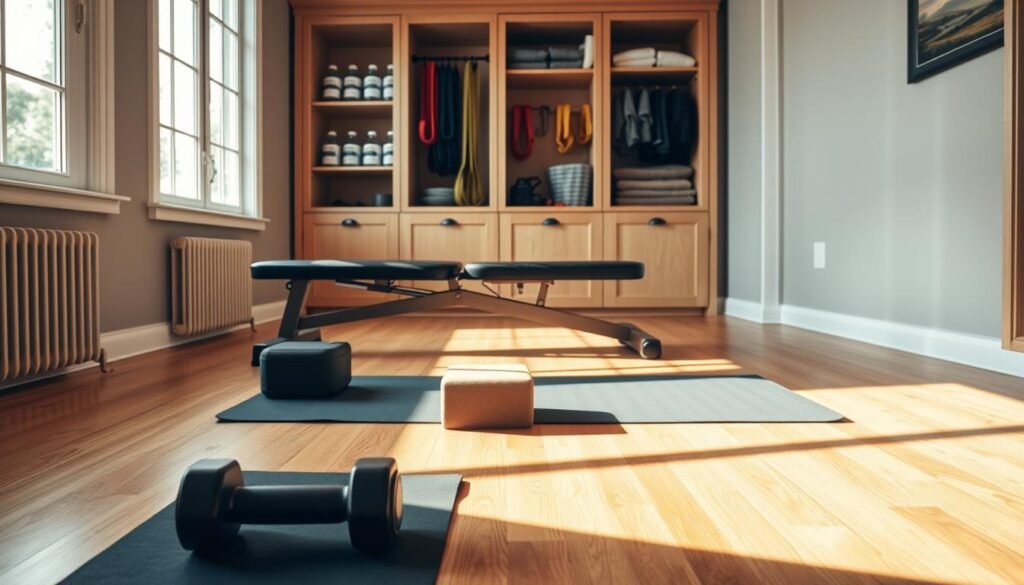
Organizing Equipment and Accessories
Clutter can stop you from staying consistent. Here are some home workout tips to keep things neat:
- Use wall-mounted racks for weights or bands
- Store small items like yoga blocks in stackable bins
- Choose multi-functional furniture, like ottomans with storage
If you have hardwood floors, use interlocking foam tiles to protect them and reduce noise. Apartment folks might prefer a thick yoga rug that’s easy to roll up. Label your storage containers to save time looking for gear during your workout.
Essential Equipment for Home Workouts
Creating a home gym doesn’t need to be expensive or take up a lot of space. You just need the right tools to start your fitness journey. Whether you’re making your own exercise plans or following online guides, choosing the right equipment is key. It helps you get the most out of your workouts without cluttering your space.
Must-Have Gear for Beginners
A yoga mat is a must for comfort and grip during floor exercises. Add resistance bands to your list—they’re light, cheap, and great for strengthening muscles. Adjustable dumbbells are also a good choice for strength training without taking up too much room.
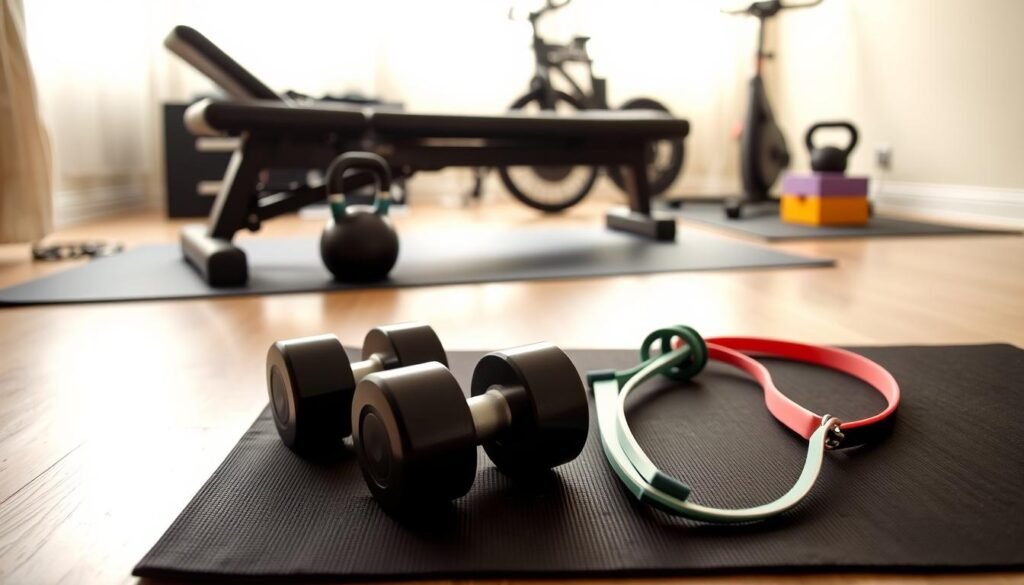
Don’t have weights? No worries. Use water bottles as dumbbells or a sturdy chair for tricep dips. These simple swaps let you try out exercises at home before buying more expensive gear.
Optional Equipment to Consider
Once you’ve got the basics down, think about adding more:
- Kettlebells for full-body exercises
- A stability ball for core workouts
- Foam roller for recovery
While not necessary, these items can spice up your home workouts. Start with affordable basics and then add more as your fitness goals grow.
Developing a Workout Routine
Starting a workout habit begins with a routine that fits your energy and life. Let’s look at how to make at-home fitness plans that are fun and effective.
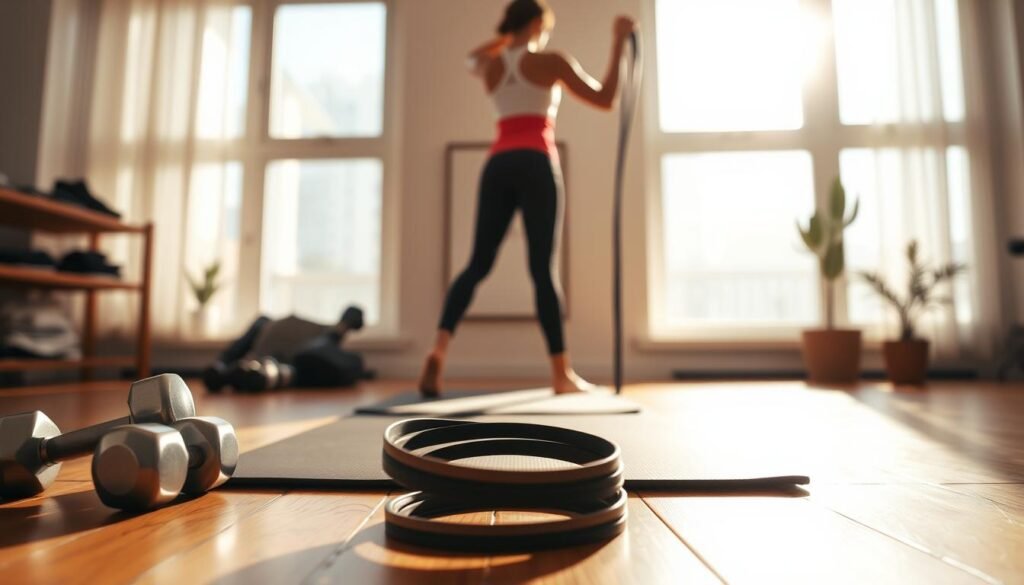
Types of Exercises to Incorporate
Combine these four types for a well-rounded at-home fitness plan:
- Strength training: Try push-ups, squats, and rows with resistance bands
- Cardio bursts: Jumping jacks, mountain climbers, or stair climbs
- Flexibility work: Yoga or dynamic stretching
- Balance practice: Single-leg stands or pilates moves
Balancing Cardio and Strength Training
Do 3-4 strength workouts and 2-3 cardio sessions a week. Here’s a simple plan for beginners:
| Day | Focus | Duration |
|---|---|---|
| Monday | Full-body strength | 25 minutes |
| Wednesday | HIIT cardio | 20 minutes |
| Friday | Yoga + core work | 30 minutes |
Setting Realistic Goals
Begin with achievable goals. Your first week might aim for:
- Three 20-minute workouts
- Learning two new exercises
- Drinking enough water every day
Boost your effort by 10% each week. This could mean more reps, heavier weights, or longer workouts. Celebrate reaching milestones like four weeks of consistent workouts or mastering a tough move.
Understanding Different Workout Styles
Not every exercise style fits everyone. Exploring different options helps you find what suits your goals and lifestyle. Whether you aim to build strength, improve flexibility, or boost endurance, there are beginner-friendly methods for your home.
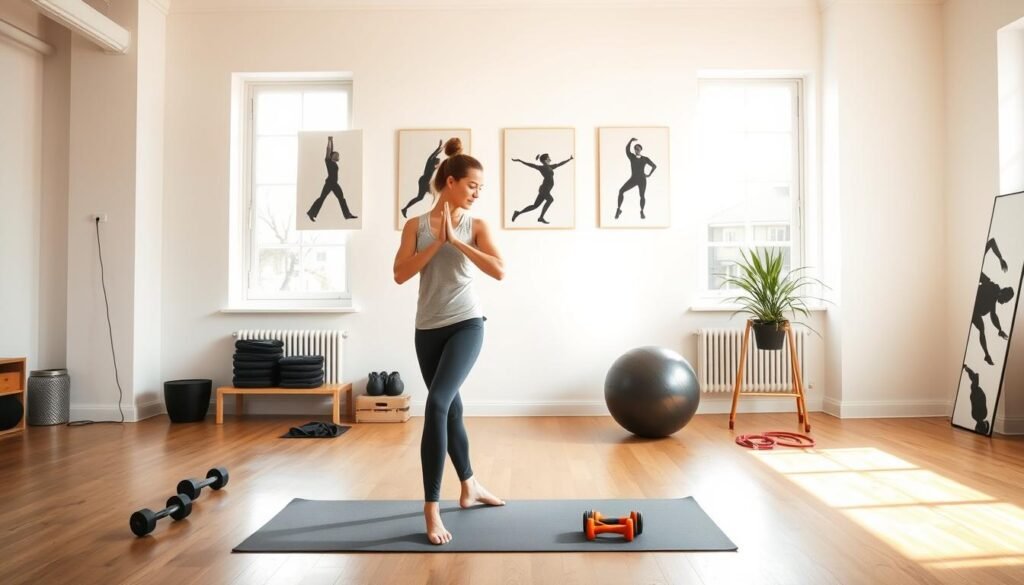
Bodyweight Exercises
No equipment? No problem. You can use your own weight to build muscle with exercises like bridges, squats, and lunges. If standard pushups are too hard, try knee pushups. Here are some variations:
- Glute bridges (hold for 3 seconds at the top)
- Chair-assisted squats
- Side lunges with towel slides
Yoga and Stretching
Improve flexibility and reduce stress with 15-minute daily sessions. Focus on poses like downward dog or child’s pose. Modify stretches by using pillows for support or shortening hold times. Pair yoga with deep breathing to enhance relaxation.
High-Intensity Interval Training (HIIT)
Short on time? HIIT mixes bursts of effort (like jumping jacks) with rest periods. Beginners can adjust intensity:
| Style | Work Interval | Rest Time |
|---|---|---|
| Timed HIIT | 20 seconds | 40 seconds |
| Rep-Based HIIT | 8-10 reps | 30 seconds |
Start with 2-3 weekly HIIT sessions and increase as your stamina improves. Always warm up first to prevent injuries.
Utilizing Online Resources
Your living room can turn into a top-notch gym with digital tools. Online platforms offer endless ways to boost your home workouts. They provide guided exercises and expert tips. Let’s see how to use these resources well, keeping your home workout tips safe and effective.
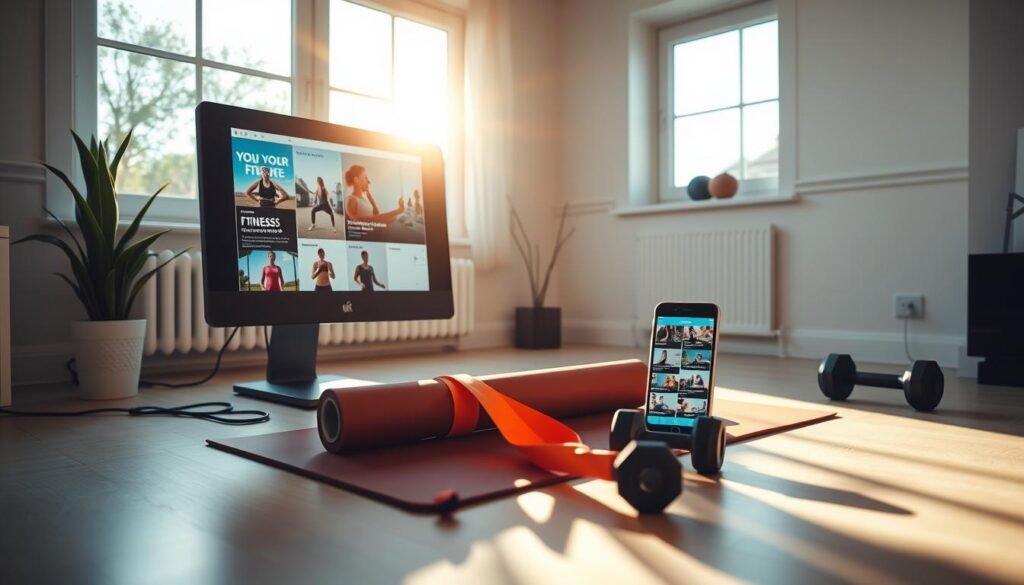
Free Workout Videos and Apps
YouTube has thousands of free workouts for beginners. Channels like FitnessBlender and HASfit offer 20-minute routines without any equipment. They’re great for small spaces. Apps like Nike Training Club and Hinge Health provide video lessons and track your progress.
When picking free resources, look for:
- Content that shows the right exercise form
- Includes warm-up and cool-down parts
- Offers adjustments for various fitness levels
Following Fitness Influencers and Coaches
Social media trainers can spice up your workouts. But, the quality can vary. Seek out certified pros like Kayla Itsines (SWEAT app) or Yoga With Adriene. They share free home workout tips and paid programs for more detailed guidance.
Before joining any influencer’s program, check their credentials and reviews. Many trusted coaches are listed in best online workout programs directories. These sites ensure trainers are safe and effective. Remember, quality teaching is more important than the number of followers.
Staying Motivated at Home
Keeping up with your home workout routine can be tough. Netflix and chores often get in the way. The key is to make exercise a must-do part of your day. Let’s look at two ways to stay on track without it feeling like a burden.
Create a Workout Schedule That Sticks
Experts say habit stacking works well. This means linking your workouts to things you already do. For example, do yoga with your morning coffee or squats while dinner cooks. Here are some tips backed by science:
| Method | How It Works | Best For |
|---|---|---|
| Time Blocking | Color-code workout slots on your digital calendar | Busy professionals |
| Movement Snacks | 3-5 minute activity bursts every 90 minutes | Parents/WFH workers |
| Accountability Pairing | Text a friend before/after each session | Social exercisers |
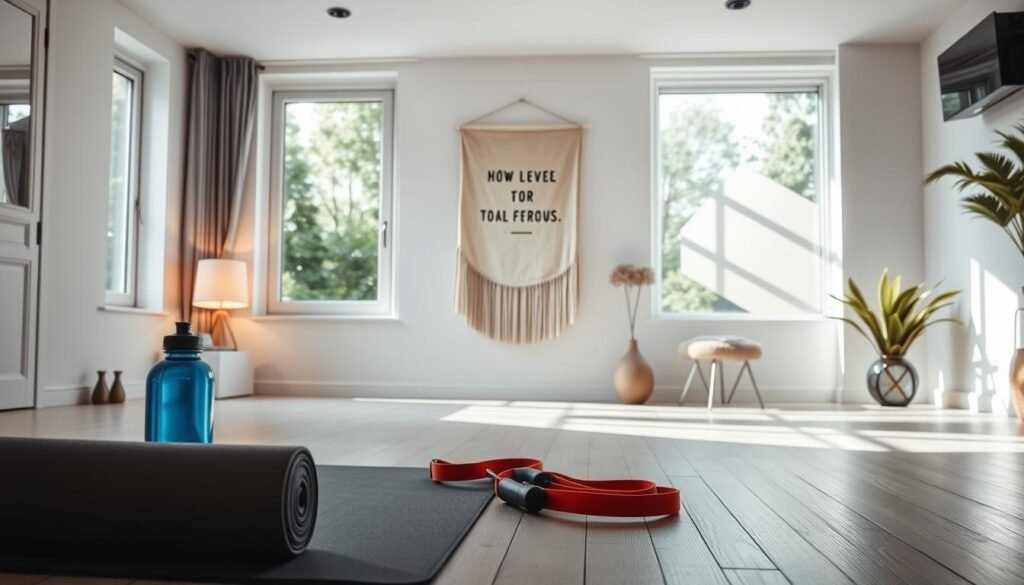
Power Up Through Virtual Fitness Groups
Online groups give you the buzz of group classes from home. Some top picks include:
- Facebook groups with daily check-ins
- Zoom challenges through local gyms
- Instagram Live workout parties
Studies show people who post workout selfies do 23% more workouts. As one Reddit user shared: “Our virtual spin crew cheers louder than my gym ever did!”
Tracking Your Progress
Seeing results from your fitness at home journey isn’t just about stepping on a scale. It’s about tracking progress to stay motivated. You can use old-school methods or tech tools to track your journey. This helps you see patterns and stay accountable.
Keeping a Fitness Journal
Writing down daily workouts in a notebook helps you spot trends. Record exercises, reps, and how you felt. This method is great for those who like hands-on feedback and want to avoid screens.
Track non-scale victories like:
- Walking up stairs without getting winded
- Falling asleep faster at night
- Reaching further in toe touches
“Journaling builds mindfulness around fitness habits,” notes a Hinge Health study. “It turns abstract effort into concrete achievements.”
Using Apps and Wearables
Digital tools automatically log metrics like heart rate variability and active minutes. Popular apps sync with smartwatches to show real-time data about your fitness at home sessions. Look for features like:
- Custom workout plans
- Hydration reminders
- Community challenges
| Method | Benefits | Best For |
|---|---|---|
| Fitness Journal | Low-tech, personal reflection | Mindfulness seekers |
| Tracking Apps | Data-driven insights | Tech enthusiasts |
| Smartwatch | 24/7 health monitoring | Goal-oriented users |
Nutrition and Hydration for Fitness
Your home workouts need the right fuel to succeed. What you eat and drink affects your energy, muscle recovery, and how well you perform. Let’s explore how to improve nutrition and hydration for better results.
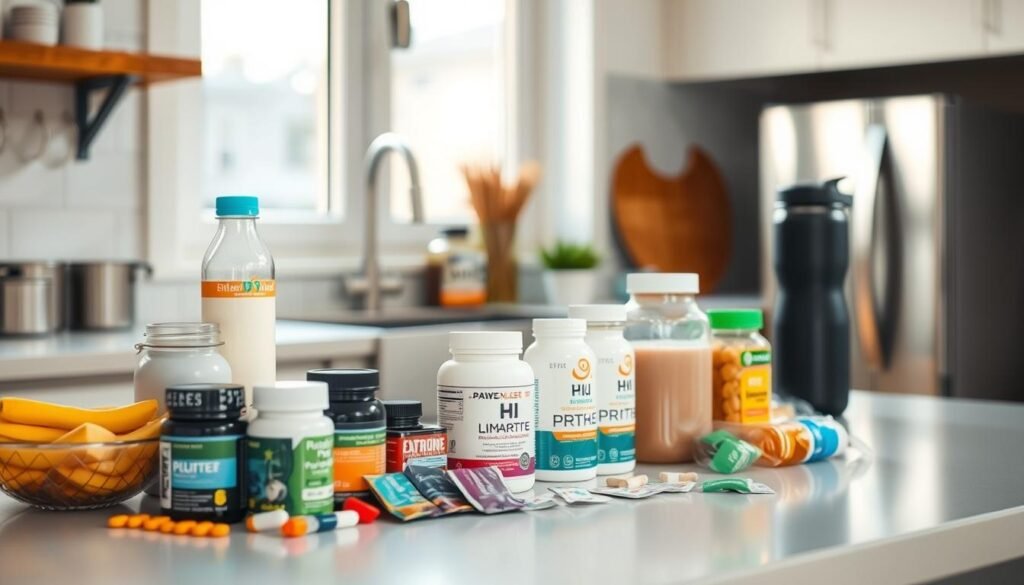
Importance of a Balanced Diet
Think of food as your workout partner. A balanced diet with lean proteins, complex carbs, and healthy fats keeps your energy steady. For example:
- Pre-workout: Eat a banana or oatmeal 30-60 minutes before exercising
- Post-workout: Pair Greek yogurt with berries to rebuild muscles
- Snack smart: Keep almonds or hard-boiled eggs nearby for quick protein
Timing is key. Smaller, frequent meals are better than big meals that make you feel slow during exercise routines for home sessions.
Staying Hydrated During Workouts
Water does more than quench thirst – it helps regulate body temperature and keeps joints lubricated. Follow these tips from hydration experts:
- Drink 17-20 oz of water 2-3 hours before working out
- Sip 7-10 oz every 10-20 minutes during exercise
- Replenish with 16-24 oz after finishing
Make hydration fun with infused water recipes:
“Add cucumber slices + mint leaves to your water bottle for a refreshing twist that encourages consistent sipping.”
Watch for signs of dehydration like dizziness or dark urine. These are signs you need to drink more water.
Overcoming Common Challenges
Starting a home workout routine can face unique obstacles. But, these challenges are solvable. Whether it’s distractions or mental fatigue, small changes can keep you on track. Let’s look at practical solutions for common issues.
Dealing with Distractions
Household noise and cramped spaces can test your focus. Here are some fixes:
- Use noise-canceling headphones during high-intensity sessions
- Place a “Do Not Disturb” sign on your workout area door
- Swap afternoon workouts for early mornings when the house is quiet
| Challenge | Solution | Tools/Resources |
|---|---|---|
| Limited floor space | Foldable yoga mat + wall-mounted equipment | Resistance bands, doorframe pull-up bar |
| Persistent joint pain | Low-impact exercises + proper warm-ups | Foam roller, instructional videos |
| Constant interruptions | Scheduled workout blocks + family communication | Shared calendar apps, visual timers |
Avoiding Burnout
Pushing too hard can lead to exhaustion. Balance your workouts with rest:
- Schedule 1-2 rest days weekly
- Alternate between cardio and strength days
- Track energy levels using fitness apps
If motivation drops, try 9 proven strategies. Start with the “5-minute rule” – commit to just five minutes, then decide if you’ll keep going. Most people continue once they start.
Pro Tip: Listen to your body’s signals. If soreness lasts more than 72 hours, try yoga instead of HIIT. Feeling drained? Make sure to hydrate and check your protein intake. Getting started with working out at home means adapting – not forcing – your routine.
Celebrating Your Achievements
It’s important to recognize your progress in your at-home fitness plans. Small victories boost your confidence and make habits stick. Seeing your milestones helps you understand how far you’ve come, even if it’s not always obvious.
Recognizing Milestones
Mark important moments like finishing a 30-day workout streak or doing your first push-up. Use apps like MyFitnessPal or Fitbit to track your progress. Write down your thoughts each week to see how far you’ve come.
Focus on showing up regularly, not just doing one big workout. It’s better to do three good workouts than one intense one.
Rewarding Yourself for Progress
Give yourself something special when you reach a goal. Get new resistance bands from Nike or Lululemon. Or, treat yourself to a rest day or a favorite show.
Sharing your wins online, like in Apple Fitness+ groups or on Reddit, adds motivation. Getting recognition, whether from others or yourself, helps keep you going. Every step forward is worth celebrating, showing that it’s progress, not perfection, that matters.
FAQ
What are the main benefits of working out at home compared to gyms?
Home workouts are convenient and save money (no gym fees). You can schedule workouts easily and avoid travel time. They also let you work out in a comfy place and tailor routines to your liking. Studies show they can reduce stress and improve heart health over time.
How do I set realistic fitness goals as a beginner?
Use the SMART framework for goals. Make them Specific, Measurable, Achievable, Relevant, and Time-bound. Start by testing your fitness with simple tests like timed planks or wall sits.
Can I build muscle without expensive equipment?
Yes, you can. Use bodyweight exercises like pushups and resistance bands. Even water bottles can be used as dumbbells. To get stronger, add more reps or try harder versions of exercises.
What’s the best way to design a weekly home workout schedule?
Mix HIIT (like 20-minute Tabata sessions), strength training (3 sets of squats/lunges), and active recovery (like yoga). For example, do HIIT on Monday and Wednesday, strength training on Tuesday and Thursday, yoga on Friday, and walks on the weekend. Adjust based on how you feel.
How do I stay motivated without gym buddies or trainers?
Use behavioral triggers to stay on track. Lay out your workout clothes every night or join free challenges like #75Hard. You can also work out with friends online using apps like Strava. Keep track of your progress and reward yourself with non-food items like new workout gear.
What flooring is safe for high-impact home workouts?
Use interlocking foam tiles (like Amazon Basics) or thick yoga mats (Manduka PRO) for shock absorption. If you have hardwood floors, wear grippy shoes like Nike Metcons. Carpeted areas are good for yoga but might limit sliding movements.
How can I modify workouts for small spaces like apartments?
Make the most of vertical space with door pull-up bars (Perfect Fitness Multi-Gym) and foldable equipment. Use hallways for walking lunges or TRX anchors. Even a small 6×6 ft area can be enough for mat-based workouts—try FitnessBlender’s low-space HIIT videos.
Are free YouTube workouts effective for building fitness?
Yes, but choose channels with certified trainers. Look for NASM-certified trainers like Heather Robertson or HASfit. Avoid extreme moves and choose workouts with proper form cues. Use apps like Nike Training Club for structured plans too.
What nutrition strategies support home workouts?
Eat carb-rich snacks (like bananas or RXBAR) 30-60 minutes before working out. After, focus on protein (like Greek yogurt) and hydration with electrolyte tabs (Nuun). For evening workouts, eat light meals like grilled chicken salads to avoid discomfort.
How do I measure progress without a scale?
Track non-scale victories like increased reps or better sleep scores. Take monthly progress photos and log your energy levels in a journal like the Panda Planner.
What’s the fastest way to recover after home workouts?
Use dynamic stretching after working out and foam rollers (TriggerPoint GRID) for muscle relief. For sore muscles, try Epsom salt baths or massage guns (Theragun Prime). Stay hydrated with coconut water and get 7-9 hours of sleep for muscle repair.
How do I avoid burnout with home exercise routines?
Schedule mandatory rest days and mix up your workout types weekly (try dance cardio via Steezy Studio). Never skip more than one day in a row. For mental blocks, do 10-minute “micro-workouts” instead of full sessions.
